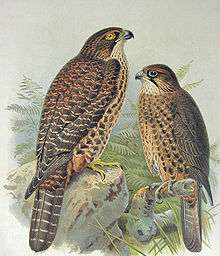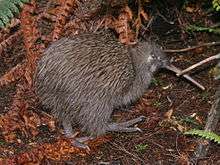New Zealand falcon
| New Zealand falcon | |
|---|---|
| | |
| Scientific classification | |
| Kingdom: | Animalia |
| Phylum: | Chordata |
| Class: | Aves |
| Order: | Falconiformes |
| Family: | Falconidae |
| Genus: | Falco |
| Species: | F. novaeseelandiae |
| Binomial name | |
| Falco novaeseelandiae Gmelin, 1788 | |
The New Zealand falcon or kārearea (Falco novaeseelandiae) is New Zealand's only falcon and the only remaining diurnal bird of prey endemic to New Zealand. Other common names for the bird are bush hawk and sparrow hawk. It is frequently mistaken for the larger and more common swamp harrier.
Description

A member of the bird family Falconidae, the Kārearea or New Zealand falcon is mainly found in heavy bush and the steep high country in the South Island, and is rarely seen north of a line through the central area of the North Island. A small population also breeds on the Auckland Islands; the species is known from the Chatham Islands from fossil remains. Although protected since 1970, it is considered to be a threatened species.[2]
Ornithologists variously described the New Zealand falcon as an aberrant hobby or as allied to three South American species (F. deiroleucus, F. rufigularis, and F. femoralis); however molecular phylogenetic studies show that Kārearea is most closely related to the South American Aplomado falcon[3] Two forms are apparent from their significantly different sizes with the larger race in the South Island and the smaller in the North Island. Although neutral genetic markers show a recent history of these two forms, the substantial size difference is likely to be driven by ecological adaptation. Conservation management had already avoided mixing of the North Island (Falco novaeseelandiae ferox) and South Island (Falco novaeseelandiae novaeseelandiae) populations.[4]
It differs from the much larger swamp harrier (or Kāhu), common throughout New Zealand, in that it catches other birds on the wing, and seldom eats carrion. An aggressive bird that displays great violence when defending its territory, the New Zealand falcon has been reported to attack dogs, as well as people.
With a wingspan around 45 cm (18 in) and weight rarely exceeding 450 g (16 oz), the New Zealand falcon is slightly over half the size of the swamp harrier, which it usually attacks on sight. The male is about two-thirds the weight of the female.[5]
The New Zealand falcon nests in a scrape in grassy soil or humus in various locations: under a rock on a steep slope or on a rock ledge, among epiphytic plants on a tree branch, or under a log or branch on the ground,[6][7] making the two or three eggs that they lay vulnerable to predators such as stray cats, stoats, weasels, possums, and wild dogs.
Falcons for Grapes programme
In 2005, funding was given by the Ministry of Agriculture and Forestry towards a programme that uses the falcons to control birds that damage grapes and act as pests in vineyards as well as monitoring the birds and establishing a breeding population in the vicinity of the Marlborough wine region.[8] Initially, four falcons were relocated to the vineyards from the surrounding hills. After the release of a further 15 birds breeding began to occur - the first time it is thought to have happened since land clearance 150 years ago. A major ongoing threat to the birds is electrocution on electricity distribution transformers with a fifth of the birds killed in this manner.[9][10]
Cultural references
The New Zealand falcon features on the reverse of the New Zealand $20 note and has twice been used on New Zealand stamps. It was also featured on a collectable $5 coin in 2006.[11]
The Royal New Zealand Air Force's aerobatic team is called the Black Falcons.[12]
See also
References
- ↑ BirdLife International (2012). "Falco novaeseelandiae". IUCN Red List of Threatened Species. Version 2013.2. International Union for Conservation of Nature. Retrieved 26 November 2013.
- ↑ "Department of Conservation". Retrieved 20 February 2012.
- ↑ Fuchs, J., Johnson, J.A. & Mindell, D.P. 2015. Rapid diversification of falcons (Aves: Falconidae) due to expansion of open habitats in the Late Miocene. Mol. Phylogenet. Evol. 82: 166–182.
- ↑ Trewick SA, Olley L. 2016. Spatial size dimorphism in New Zealand’s last endemic raptor, the Kārearea Falco novaeseelandiae, coincides with a narrow sea strait. IBIS 158: 747–761
- ↑ Heather, Barrier; Robertson, Hugh (2005). The Field Guide of the Birds of New Zealand (Revised ed.). North Shore, New Zealand: Penguin Books. pp. 277–278. ISBN 978-0-14-302040-0.
- ↑ Marchant, S.; Higgins, P.J., eds. (1993). Handbook of Australian, New Zealand and Antarctic Birds. Volume 2: Raptors to Lapwings. Melbourne: Oxford University Press. p. 287. ISBN 0-19-553069-1.
- ↑ Robertson, C.J.R., ed. (1985). Reader's Digest Complete Book of New Zealand Birds. Surry Hills, NSW: Reader's Digest. pp. 154–155. ISBN 0-949819-97-2.
- ↑ "SFF Project Summary". Ministry of Agriculture and Forestry. Retrieved 25 February 2010.
- ↑ "Falcons Return to Wairau Plain". Ministry of Agriculture and Forestry (press release). 2007-12-13. Retrieved 25 February 2010.
- ↑ "Protection sought for vineyard falcons". Radio New Zealand. 2010-02-25. Retrieved 25 February 2010.
- ↑ 2006 New Zealand Falcon coin sets. Accessed 6 April 2006.
- ↑ "New air force planes 'a huge step up'".
Further reading
- Crichton, Sandy (May 2009), "On a wing and a prayer", Forest & Bird, pp. 21–25
- Seaton, Richard (2007), "The ecological requirements of the New Zealand falcon (Falco novaeseelandiae) in plantation forestry.", Unpublished PhD thesis, Massey University, Palmerston North
- Thomas, Andrew C.W. (2008), "The Behaviour and Development of New Zealand Falcons (Falco novaeseelandiae) Nesting in a Plantation Forest.", Unpublished MSc thesis, Massey University, Palmerston North
External links
| Wikimedia Commons has media related to Falco novaeseelandiae. |
- Wingspan Birds of Prey Trust - The national centre for the conservation, education and advocacy of birds of prey in New Zealand. Location: Rotorua, NZ.
- Raptor Association of New Zealand
- New Zealand Falcon New Zealand Birds Online
- New Zealand falcon/Kārearea at Department of Conservation (New Zealand)
- New Zealand Falcon at Birdlife International
- New Zealand falcon at Te Ara Encyclopedia of New Zealand
- Assessment of the potential for the integration of New Zealand falcon conservation and vineyard pest management
- Marlborough Falcon Conservation Trust
- Raptor Alliance for New Zealand

